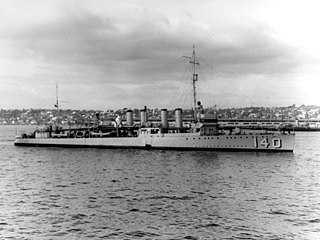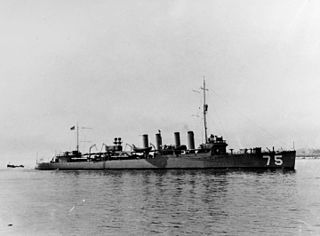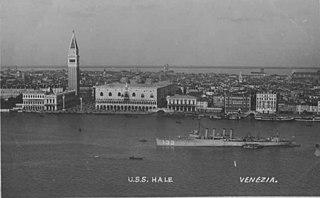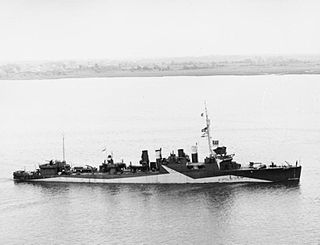
USS Cole (DD-155) was a Wickes-class destroyer in the United States Navy during World War II, later reclassified as AG-116. It was named for Edward B. Cole, a United States Marine Corps officer who died as a result of the wounds he received at the Battle of Belleau Wood.

USS Claxton (DD-140), named for Thomas Claxton, was a Wickes-class destroyer in the United States Navy. Entering service in 1919, the destroyer saw intermittent use during the interwar period. During World War II, Claxton was transferred to the Royal Navy and renamed HMS Salisbury. The ship saw service in the Battle of the Atlantic before sold for scrapping in 1944.

USS Jacob Jones (DD-130), named for Commodore Jacob Jones USN (1768–1850), was a Wickes-class destroyer. She was sunk by a German submarine in 1942 during World War II.

USS Dickerson (DD-157) was a Wickes-class destroyer in the United States Navy, and was converted to a high-speed transport at Charleston, South Carolina and designated APD-21 in 1943. She was named for Mahlon Dickerson (1770–1853), Secretary of the Navy from 1834 to 1838.

The first USS Wickes (DD-75) was the lead ship of her class of destroyers in the United States Navy during World War I, later transferred to the Royal Navy as HMS Montgomery. She has been the only ship of the Royal Navy to bear the name Montgomery.

USS Fairfax (DD-93) was a Wickes-class destroyer in the United States Navy during World War I, later transferred for World War II service first to the Royal Navy as HMS Richmond (G88), a Town-class destroyer, and then to the Soviet Navy as Zhivuchy.

USS Williams (DD-108) was a Wickes-class destroyer in the United States Navy entering service in 1919, and was the second ship to bear the name. Following a brief stint in active service, the ship was laid up for 17 years before being reactivated during World War II. Williams transferred to the Royal Canadian Navy during World War II as part of Lend-Lease and was renamed HMCS St. Clair (I65), surviving the war and being scrapped in 1946.

The first USS Hale (DD–133) was a Wickes-class destroyer in the United States Navy during World War I, later transferred to the Royal Navy as HMS Caldwell (I20). She was named for Senator Eugene Hale.

The first USS Yarnall (DD–143) was a Wickes-class destroyer in the United States Navy during World War I later transferred to the Royal Navy as HMS Lincoln, to the Royal Norwegian Navy as HNoMS Lincoln, and subsequently to the Soviet Navy as Druzhny.

USS Upshur (DD–144) was a Wickes-class destroyer in the United States Navy before and during World War II. She was the first ship named for Rear Admiral John Henry Upshur.

The first USS Thatcher (DD–162) was a Wickes-class destroyer in the United States Navy, later transferred to the Royal Canadian Navy as HMCS Niagara.

USS Maddox (DD–168) was a Wickes-class destroyer in the United States Navy during World War I. She was later transferred to the Royal Navy as HMS Georgetown (I40), to the Royal Canadian Navy as HMCS Georgetown, and then to the Soviet Navy as Doblestny . She was the last "four piper" destroyer to be scrapped.

The first USS Kalk (DD–170) was a Wickes-class destroyer in the United States Navy during World War I, later transferred to the Royal Navy as HMS Hamilton (I24) and then into the Royal Canadian Navy as HMCS Hamilton (I24).

The first USS Hopewell (DD–181) was a Wickes-class destroyer in the United States Navy, entering service in 1919. After a brief active life, the ship was deactivated in 1922 and placed in reserve for 18 years before returning to service in 1940 during World War II. She was later transferred to the Royal Navy as HMS Bath (I17), as a Town-class destroyer, and then to the Royal Norwegian Navy as HNoMS Bath. Bath was torpedoed while escorting a trans-Atlantic convoy on 19 August 1941.

USS Satterlee (DD-190) was a Clemson-class destroyer in the United States Navy, entering service in 1919. After brief service until 1922, the ship was placed in reserve. The ship was reactivated for World War II before being transferred to the Royal Navy in 1940. Renamed HMS Belmont, the destroyer was used as a convoy escort in the Battle of the Atlantic where she was torpedoed and sunk on 31 January 1942.

USS Hunt (DD-194) was a Clemson-class destroyer in the United States Navy following World War I. She also served in the United States Coast Guard, as USCGD Hunt (CG-18). She was later transferred to the Royal Navy as HMS Broadway (H90).

USS Herndon (DD-198) was a Clemson-class destroyer in the United States Navy. Herndon served in the United States Coast Guard as CG-17. She was later transferred to the Royal Navy as HMS Churchill and still later to the Soviet Navy as Deyatelny.

USS Truxtun (DD-229) was a Clemson-class destroyer in the United States Navy during World War II. She was the third ship named for Thomas Truxtun.

USS Edwards (DD-265) was a Clemson-class destroyer in the United States Navy and transferred to the Royal Navy where she served as HMS Buxton (H96) and later in the Royal Canadian Navy during World War II.

USS Eberle (DD-430) was a Gleaves-class destroyer of the United States Navy. The ship is named for Rear Admiral Edward Walter Eberle, who commanded the Atlantic and Pacific Fleets and was Chief of Naval Operations from 1923 to 1927. The destroyer entered service in 1940 and spent the majority of her career in the Atlantic Ocean. Placed in reserve following the war, the ship was transferred to the Hellenic Navy in 1951. Renamed Niki, the destroyer remained in service until 1972 when she was scrapped.




















